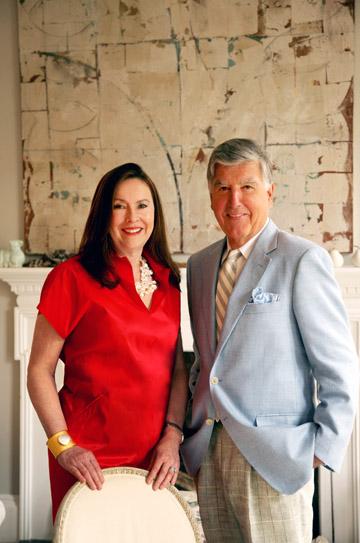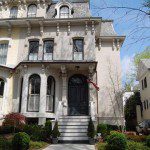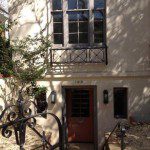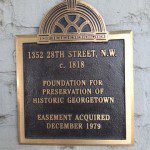Getting to the Heart of the Georgetown House Tour
By • May 17, 2012 0 2509

If you’re one of those persons who’ve been on a few Georgetown House Tours, you begin to get a notion about some of the things the tour might be about.
The tour is about history, for sure—about the homes being shown, about the people who have lived in them and live in them now, about change in Georgetown and change in how people live. For all the historic, stately qualities of Georgetown, it’s a remarkably fluid place, and you can see that in the homes that are being shown. Those houses, acting like official greeters, may show a part of the past, and a part of the present to visitors all at the same time
Georgetown is after all a historic district where wholesale physical change is difficult to achieve—but things are often going on inside that speak to the modern and to the future, as well as individual style and taste.
People flock to the Georgetown House Tour with expectations that they will see a portion of the lives and looks of the persons who occupy and own these houses and that they will reflect the village of people with residents who know how to live with style and grace. They also expect to see the living breath of history—the occasional antique piece of eye-popping furniture, paintings, gardens, the work of fabulous interior decorator, the timeless touch of the history of the homes themselves. To visitors, Georgetown can seem like Brigadoon, separate from its surroundings.
All of these elements come together in the annual spring Georgetown House Tour, sponsored by historic St. John’s Episcopal Church and benefits many of its long-time charitable activities. Like many “festive” or “tour” events in the city, it has grown and branched out over the years, adding social occasions—the Patrons’ Party, for instance—and mini-events on the day of the tours like the hugely popular afternoon tea at St. John’s.
And every year, there are people who gather together to lend their resources, talents, time and efforts to ensure the event’s success. There are volunteers, quasi-docents, ticket-takers, information providers and so on. There are corporate sponsors, such as Washington Fine Properties, and there are the folks who lend their name and their time and effort as the co-chairs and the kind folks who open their homes.
This year, the co-chairs — Frank Randolph, a renowned interior designer and Stephanie Bothwell, who heads her own business called Urban and Landscape Design — combine with Frida Burling, long the soul and inspiration of the Georgetown House Tour, to bring together themes of history, interior and exterior designs, i.e., how we live in our homes and communities and share the best of those qualities with each other and the world.
Randolph, known for his enchanting interior designs, is ideally suited for his role as co-chair: He is, without a doubt, one of the village’s most unabashed boosters, a native son, born and raised in Georgetown, a student at Western High before it became Duke Ellington School for the Arts. Bothwell is a relative newcomer to Georgetown, having lived here with her family for 12 years, but she brims with a passion for the village and ideas about achieving ideal and workable designs for urban living.
Burling, who for years with an energy that surprises people to this day, made sure that the tour would come off every year—by marketing, by cajoling, persuading, charming, pushing and using her considerable contacts to make it happen. She became the face and voice of the tour, it’s most able, articulate promoter. In 2001, when Ben Bradlee and Sally Quinn hosted the tour’s patrons’ party, the Georgetowner newspaper arrived at their N Street home to take a cover photo. An editor asked Bradlee why he was involved, and the Washington Post executive editor roared back: “Because Frida told me to.”
The combination of the three speaks the best of Georgetown, a sense of a community with historic offerings that presents a graceful face to the world and to itself, for that matter.
“It goes without saying, “ Randolph says. “One of the key components is the fact that all of us, the residents of Georgetown, get to visit each other at one time or another. It’s a community thing that way.”
Of course, Randolph combines the historic with designer know-how and appreciation as well as an articulate, busy knowledge of his favorite place. “I can think of only a few houses in Georgetown that I’ve not been in,” he says. “And, over the years, I’ve done the interior design for, I don’t know, 30 or 40 homes. Of course, that includes my own home.” It is on 34th Street near Dent Place and has a certain cache beyond his own ownership, which is no small thing either. “Henry Kissinger lived here for a few years,” he says. If you want cache, or just history chat, talk with Randolph. His father was a senator from West Virginia. Randolph was asked to redecorate the Vice President’s Residence when the Cheneys lived there. “I had a privileged upbringing, you could say, but not spoiled or extravagant,” he said. “I was and still am very appreciative of the opportunities.”
The world comes to tour the nine Georgetown homes on Saturday, April 28. It used to spread over two days on a spring weekend but has since been held on Saturday only. “Georgetown presents one of the better illustrations of livable urban design, I’m not talking about showing off a collection of solar panels or being green. It’s about ease of movement, access and connection,” Bothwell said.
“The house tour shows people the history here, sure, but I think it also shows how you can manage change in interior ways, what you can do with old homes to make them more contemporary while keeping the history and beauty,” she said. “We have a remarkable variety in housing stock here—it’s not all mansions and big properties, although we have plenty of that here. It’s livable, manageable homes, some quite small. And the homes are very deceptive from the outside; they give off the historic feeling without revealing their depth or size.”
Echoing that theme, Randolph said, “I absolutely love Georgetown. I have everything here I need. I can walk to the Safeway or Whole Foods and restaurants galore. We have the firemen at Dent Place nearby. It’s fluid, it changes and the people change. But it has tradition. It has history that’s permanent. And I think you can see that reflected on the tour. I’ve lived here most of my life, and I wouldn’t live anywhere else
Randolph, a Georgetowner par excellence, can tell you about the various schools—Hardy, Hyde, Western—and the people who have lived here. He knows lots of people and has a host of friends. “I live by myself,” he says. “I don’t even have a pet. I have a porcelain dog. He’s the perfect pet. You don’t have to walk or feed him, and he’s always there for you. But I share this place with my friends, this lovely village.”
Frida Burling can tell you a little about life in Georgetown herself, too. At 96, she’s seen and done a lot in her village. In a phone conversation, she tells you she’s slowing down—then rattles off a series of activities, meetings with relative, church, another meeting Sunday afternoon—that indicates she still keeps a busy schedule. She is the tour chair emerita and is hosting the Patron’s Party on April 25.
She recalls how she first got involved in the house tour, which had begun during the Depression as a small thing, probably with people in a bus going by houses. “My husband and I (the late Edward Burling, whom she still refers to as Eddie) used to go on weekends out to Middleburg, but that’s hunt country, and it’s not Georgetown. I got involved with St. John’s which is so much a center of all this with their many projects. Eventually, I got involved in the house tour, because that’s a way to support those charitable projects like the Georgetown Ministry.”
No question about it, she propelled the house tour into its next incarnation to the point where it has become an institution, a must-do event and an integral part of the community’s traditions. She did it by example—her energy became legendary as she got older. She remembers asking best-selling author and biographer Kitty Kelley, a Georgetowner to the bone, to host the first patrons’ party in the late 1990s. The patron’s parties were a Burling innovation, and it enlarged the image of the tour, created a higher profile.
“I think it’s one of the oldest house tours in the country,” she said. “I know it sets an example. And, simply by being who she is, so does Frida Burling.
The 2012 Georgetown House Tour at a Glance:
From the east side to the west side, from 28th Street to 35th Street and from N Street to Q Street, the Georgetown House Tour spreads its welcome mat over Washington’s most historic neighborhood, Saturday, April 28, 11 a.m to 5 p.m. For the price of $40 ($45 after April 20), visitors and residents may walk through nine homes and the home’s grounds. It is a chance to glimpse some history, to get some decorating and home improvement ideas and to feel the ease of city living. Who would open their doors to strangers? Try at least three architects, an artist, a designer, a real estate developer and agent, a financial manager, a high-tech manager, a college dean, a lawyer and another lawyer who happens to represent Georgetown as the Ward 2 councilmember.
The following have opened their homes on behalf of the tour and deserve a big thank you from the community: Cherry and Peter Baumbusch; Kristin and John Cecchi; Pat Dixon; Michele and Jack Evans; Hugh Newell Jacobsen; Kristin and Greg Muhlner; Dale and Melissa Overmyer; Alice Hall and Peter Starr; Christian Zapatka.
There is a tea at St. John’s Church parish hall (O and Potomac Street), 2 p.m. to 5 p.m., Saturday, April 28, the day of the tour. The Patron’s Party is on April 25 at Frida Burling’s house on 29th Street.
For more information, visit GeorgetownHouseTour.com or call 202-338-1796.
- Jordan Wright
- Stephanie Bothwell and Frank Babb Randolph | Philip Bermingham.








